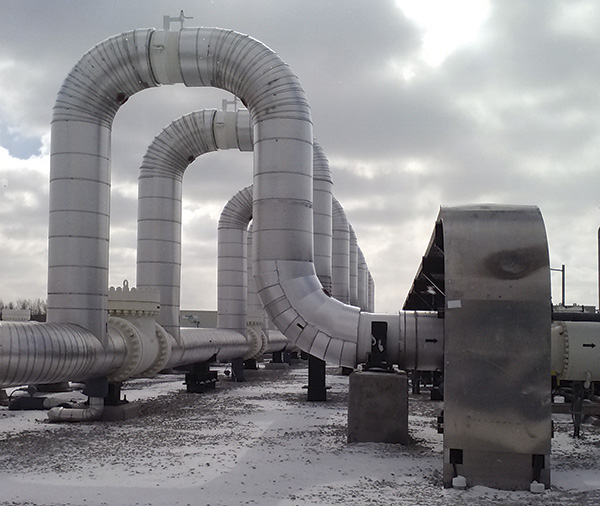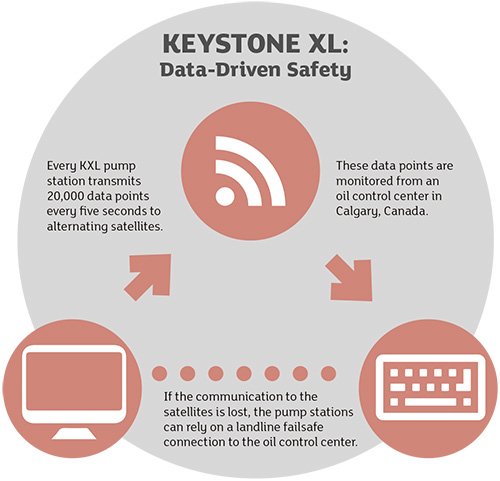STANTON, Neb. (Nov. 11, 2014)—Even as the Midwest cold dipped into the teens, the steel at Pump Station 38 was hot to the touch. Beneath the curved pipes rushed hundreds of thousands of barrels of Canadian crude oil destined for Gulf Coast refineries. Pump Station 38 is one of dozens of pump stations along the Keystone XL pipeline—a 1,200-mile addition to the Keystone system that connects Hardistry, Alberta, to Steele City, Nebraska. Six years of political debate has made the Keystone XL (KXL) project a favorite for national headlines, but the real story lies in the innovative technology that makes the expansion possible.
 Pump Station 38 at Station, Nebraska, carries Canadian oil sands crude as part of the Keystone XL expansion. (Photography by Michael Lambert)
Pump Station 38 at Station, Nebraska, carries Canadian oil sands crude as part of the Keystone XL expansion. (Photography by Michael Lambert)Mapping the Pipeline
A common misconception is that KXL will be the first oil pipeline on American soil. The pipeline is actually another addition to the Base Keystone system—the fourth phase in a crude oil transfer network that spans much of the Midwest and reaches from Canada to the Gulf of Mexico. Base Keystone started as 275 miles of pipe and five pumping stations. Now, the system and its expansions rely on more than 200 pumps to handle 47 approved petroleum products..jpg) Check valves at the entrance and exit of the pump circuit determine if the products need to enter the circuit or continue through the pipeline.
Check valves at the entrance and exit of the pump circuit determine if the products need to enter the circuit or continue through the pipeline.Pressure Control
Virgil Pfenning, area manager of Pump Station 38, said that the products move through the station at more than 1 million gallons per hour, or 660 gallons per second. This is equivalent to “walking pace,” Pfenning said. At this rate, about 550,000 barrels of crude product are handled by the station’s pumps each day. The pumps operate in parallel series, with a variable frequency drive adjusting the outgoing pressure of the final pump based on the petroleum product in the batch.
The pumps operate in parallel series, with a variable frequency drive adjusting the outgoing pressure of the final pump based on the petroleum product in the batch.
Flexibility & Monitoring
VFD control is only one aspect of the total monitoring solution responsible for the high level of reliability and safety at KXL. Ted Fowler, Siemens Oil & Gas, described the design of KXL’s automation architecture as modular—the system can handle and adapt to more pumps as the project expands. As delays from Congress and the U.S. Department of State have hampered the pipeline’s completion, this modular design has become like a “silver lining” for the pipeline’s future, Fowler said. At Pump Station 38, human-machine interfaces (HMIs) display and transmit more than 20,000 data points every five seconds to the oil control center in Calgary, Canada. Valve site data from the mainline valves between pump stations is sent every 30 seconds. Alternating satellites transfer the data, but a landline failsafe activates if communications are lost. The extensive monitoring solution is driven by a commitment from both Siemens and TransCanada to provide a safe operating environment prepared for anything. If the pipeline leaks and pressure suddenly changes, the reaction is immediate but careful. Neither the supervisory control and data acquisition (SCADA) programs nor the programmable logic controllers (PLCs) will allow the valves to close without a staggered pump shutdown. “Liquid lines are harder to shut down or bypass than gas lines,” Fowler said. If the PLCs come offline, all the pumps shut down in a cascading manner to prevent hammer in the pipeline. If SCADA loss occurs, the drives gradually move to a safe operating pressure—a tall order for a system that can reach up to 470,000 horsepower of pumping power. Ultimately, technology can never fully replace the human element. Pump Station 38 receives a minimum of one site visit per week—sometimes up to three visits. Operators at the oil control center are always on call to receive emergency alerts on the pipeline—including a recent call from a local Nebraska farmer who believed he saw a leaking pipeline. Crews responded quickly and confirmed the call was not a threat.Conclusion
While the future of KXL is still a question for politicians, the close collaboration between manufacturer and customer that has defined the project sets the model for true technical innovation in the automation and monitoring industries. The partnership between Siemens and TransCanada has combined the leading technologies in pump system configuration, motor and pressure control, and monitoring software. The result is an operating architecture that highlights safety and provides a blueprint for continued domestic and international partnerships during the U.S.’s energy golden age.KEYSTONE XL: POLITICS IN 2015
The journey to approving the Keystone XL pipeline began in 2008, and after more than six years of waiting, the project has yet to be approved fully by the U.S. government. Congress and the Obama administration have squared off over the years about the pipeline’s safety, environmental impact and role in the future of U.S. energy. Following last year’s midterm elections, a new Republican-led Congress has renewed efforts to gain approval for the pipeline once and for all.
Jan 9
The House of Representatives approves H.R. 3, the Keystone XL Pipeline Act, authored by Rep. Kevin Cramer (R-ND), which would authorize construction of the project.
Jan 29
The Senate approves S.1, the Keystone XL Pipeline Approval Act.
Feb 11
The House approves S.1, the Keystone XL Pipeline Approval Act, sending the bill approving the pipeline to the president’s desk.
Feb 24
President Barack Obama vetoes S.1, the Keystone XL Pipeline Approval Act.
March 4
The Senate fails to override the president’s veto.

